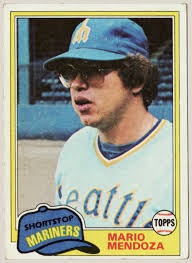The Menodza Line in baseball is a batting average of .200 and it’s named after Seattle Mariners Shortstop Mario Mendoza even though his lifetime batting average is .215. Supposedly Mendoza’s teammates Bruce Bochte and Tom Paciorek coined it and George Brett popularized it when he was batting close to .400 in 1980. Even though Mendoza had a lifetime average greater than .200, it’s still a great demarcation point.
Speaking of demarcation points, one demarcation point relates to baseball cards and that demarcation in my opinion is 1981. You’ll see articles talk about the high values of rare baseball cards and people still collect them, but the fact is that the value of baseball cards as a collectible and as an investment are almost exclusive to baseball cards prior to 1981.
Why is 1981 considered the demarcation point? 1981 is the year that Topps’ monopoly on baseball cards ended when Fleer and Donruss started producing baseball cards. So in 1980, there was one baseball set (Topps) and then there were three in 1981. In 1988, Score got a license to produce baseball cards. In 1989, Upper Deck entered the market by producing a full color, heavy-duty baseball card with pictures on both sides and a hologram attached to deter counterfeiting. Seeing what Upper Deck did; Tops, Fleer, and Donruss started producing their own high premium sets. So there were dozens of baseball sets available for purchase that produced a glut of cards that was part of the baseball card bubble that burst when the baseball strike of 1994 canceled the World Series and no one wanted to buy baseball cards. The baseball card industry has never recovered.
Even with Topps being the exclusive baseball card of Major League Baseball, Topps still produces multiple baseball sets using a variety of names and different levels of premium cards. There is too much product for collectors to collect and the fact is that younger kids don’t collect baseball cards the way kids of my generation did.
Except for a few high end, limited print rookie cards, baseball cards after 1981 have very little value in comparison to cards produced before 1981. There are two reasons for this divide. The first reason is that print runs of baseball cards prior to 1981 were a lot smaller than those printed after 1981, there were more than enough cards to meet demand. The second reason is that kids of my generation took better care of their cards. We’d put those cards away in plastic rather than put them in the spokes of our bicycle or wrap them in rubber bands or have our mothers throw them out. Baseball cards prior to 1981 are extremely hard to find in great condition, which has been highlighted by the proliferation of card grading where collectors can have their cards professionally graded by independent experts for their condition.
So a high grade Mickey Mantle card is always going to appreciate in value because of its scarcity. There isn’t as much value in the baseball cards of the modern era. I thought the rookie cards of Dwight Gooden and Gregg Jefferies would help me buy a house. These days, it can’t buy me the Sunday paper.
If you want to invest in baseball cards, stick to higher-grade cards prior to 1981.







